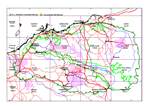Botanical name
Acacia monticola x trachycarpa
Description
Resinous shrubs 4 m tall. Bark red Minni Ritchi. Branchlets with very short, fine, wide-spreading, white hairs. Stipules persistent, triangular, about 1 mm long, scarious, brown. Phyllodes linear-oblanceolate, narrowed towards the base, 4-8 cm long, 3-4 mm wide, not rigid, green, straight to very shallowly recurved, incurved or wavy, green, ±sparsely hairy, the hairs short, wide-spreading and straight; parallel longitudinal nerves numerous, the central nerve clearly more evident than the rest, the minor nerves often longitudinally anastomosing, the upper margin clearly broader than the lower margin; apex narrowed to a fine, brown, subulate, non-spiny point 1-1.5 mm long. Inflorescences simple, 1 or 2 within axil of phyllodes; peduncles very long (15-30 mm), with hairs similar to the phyllodes; spikes short (10-15 mm long when dry). Flowers 5-merous; calyx dissected for about ˝ its length into oblong, obtuse lobes. Pods (immature) narrowly oblong, flat, straight-edged or shallowly constricted between the seeds, 2-6 cm long, about 8 mm wide, straight or sometimes curved at the base, sometimes twisted in the longitudinal plane, obscurely reticulately nerved, densely hairy with short, soft, straight, white hairs; marginal nerves thickened. Seeds (immature) oblique in the pods.
Characteristic features
Resinous shrubs. Bark red Minni Ritchi. Branchlets, phyllodes and peduncles with very short, fine, wide-spreading, white hairs. Stipules persistent, small (about 1 mm long) and brown. Phyllodes linear-oblanceolate, narrowed towards the base, 4-8 cm long, 3-4 mm wide, ±straight; parallel longitudinal nerves numerous, the central nerve clearly more evident than the rest, the minor nerves often longitudinally anastomosing; the upper margin of phyllode clearly broader than the lower margin; apex narrowed to a fine, brown, subulate, non-spiny point. Inflorescences simple; spikes short (10-15 mm); peduncles very long (15-30 mm). Pods (immature) flat, mostly, straight, sometimes twisted in the longitudinal plane, with dense, short, soft, straight, white hairs, marginal nerves thickened.
Distribution and ecology
This rare putative hybrid occurs in the Pilbara region of northwest Western Australia where it is known from a single collection along the railway access road between Tom Price and Karratha. Grows in skeletal soil along a drainage line among low rocky hills.
Flowering and fruiting period
The specimen collected in early August was with mature buds, heads at anthesis and immature pods.
Taxonomy
Judging from a critical examination of the one known collection of this taxon, it seems probable that it represents a hybrid involving the two Minni Ritchi species, A. monticola (which has shorter and broader phyllodes) and A. trachycarpa (which normally has narrower phyllodes). The general facies of the specimen is that of a broad phyllode form of A. trachycarpa but apart from its phyllode width this putative hybrid is recognized by its denser indumentum of spreading hairs on the branchlets, phyllodes and peduncles (glabrous or sparsely appressed -hairy in A. trachycarpa) and straight (not curved) pods which have white hairs (not golden) when young. The indumentum is very reminiscent of that which occurs in A. monticola , although it is generally sparser in the putative hybrid. Field examination and other study is required to confirm the provisional hybrid determination. Acacia trachycarpa also hybridizes with A. eriopoda and A. tumida var. pilbarensis in the Pilbara.
Another putative hybrid between A. monticola and A. trachycarpa is known from just north of Nullagine; it grows with A. trachycarpa along a rocky creek and although A. monticola was not observed at the locality, it does occur in the general vicinity. Whereas the entity described above has the general appearance of A. trachycarpa , this Nullagine plant has the general appearance of a very narrow form of A. monticola. The salient features of this putative hybrid are the following. Resinous, obconic shrub 2.5 m tall. Branchlets with short, straight to slightly curved hairs. Phyllodes narrowly oblong, 20-32 x 4-5 mm, straight but curved upwards from base, indumentum as on branchlets but hairs mostly on margins and nerves, longitudinal nerves 3-7 with midrib the most prominent and some of the minor nerves anastomosing, the upper margin clearly wider than lower margin (as in A. trachycarpa); apex obtuse-mucronate. Heads obloid, 7-9 mm long (when dry); peduncles 10-15 mm long, with hairs as on branchlets. Pods not seen.
Conservation status
There is insufficient information at present concerning this entity to justify including it on the Department of Environment and Conservation's Declared Rare and Priority Flora List.


